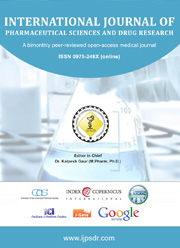Formulation Development and Evaluation of Biodegradable Stent of Atorvastatin and Clopidogrel for Treatment of Atherosclerosis
DOI:
https://doi.org/10.25004/IJPSDR.2024.160209Keywords:
Biodegradable Stent, Solvent Casting, Atorvastatin, Clopidogrel, PLGA (Polylactic-co-glycolic acid), Atherosclerosis, Lipid-lowering agentsAbstract
This study aimed to create, develop, and optimize a biodegradable stent made of poly lactic co glycolic acid (PLGA) that contained clopidogrel and atorvastatin for the management of asthma. Solvent casting was used to create biodegradable stents. In particular, PLGA 75:25 polymer films were used to create stents using the solution-casting method. The base material was created by dissolving the polymer in isopropyl alcohol and adding PEG 400 as a plasticizer. As the active pharmaceutical ingredients in the stents, clopidogrel and atorvastatin were used. To avoid air bubbles, the resulting mixture was homogenized before being poured onto metal pans and allowed to gently evaporate in a refrigerator. The polymer films were then cut into strips, wound around cylindrical rods to form helical stents, and baked in an oven to guarantee that all of the isopropyl alcohol had evaporated. The biodegradable polylactic acid stents that included clopidogrel and atorvastatin demonstrated an impressive 99.34±0.44% encapsulation efficiency. Differential scanning calorimetry (DSC) analysis revealed that there were no chemical interactions between the stent's component parts. Significant water absorption over 80% was seen over a period of 8 days, which is remarkable. A thorough effect on disrupting plaque was seen at day 21, and on day 22, the stent began to biodegrade. Over the course of 20 days, the cumulative medication release percentage rose to 99.92%. According to the study's findings, treating atherosclerosis with an optimized biodegradable polymeric stent made of PLGA and combining atorvastatin and clopidogrel is a novel and promising treatment option.
Downloads
References
Dichgans K, Pulit S. Stroke Genetics: Discovery, Biology, And Clinical Applications. Lancet Neurology. 2019; 18(6): 587-599.
Shafi SK, Ansari HR, Bahitham SW, Aouabdi FS. The Impact of Natural Antioxidants On the Regenerative Potential of Vascular Cells. Frontiers in Cardiovascular Medicine. 2019; 6(4) :28-32.
Whelton SP, Deal JA, Zikusoka MS, Jacobson LP, Sarkar S, Palella FJ, Kingsley L, Budoff M, Witt MD, Brown TT, Post WS. Associations Between Lipids and Subclinical Coronary Atherosclerosis. AIDS. 2019; 33(6) :1053-1061.
Esper RJ, Nordaby RA. Cardiovascular Events, Diabetes and Guidelines: The Virtue of Simplicity. Cardiovascular Diabetology. 2019; 18(1) :42-59.
Ala-Korpela M. The Culprit Is the Carrier, Not The Loads: Cholesterol, Triglycerides and Apolipoprotein B in Atherosclerosis and Coronary Heart Disease. International Journal of Epidemiology. 2019 ;48(5) :1389-1392.
Miller YI, Hebil HJ. Oxidation-Specific Epitopes Are Danger-Associated Molecular Patterns Recognized by Pattern Recognition Receptors of Innate Immunity. Circulation Research. 2011; 10(8) :235-248.
Gistera A, Hansson GK. The Immunology of Atherosclerosis. Nature Reviews Nephrology. 2017; 13(2) :368-380.
Tardif JC, Jevik DR. Effects of Succinobucol (AGI-1067) After an Acute Coronary Syndrome: A Randomized, Double-Blind, Placebo-Controlled Trial. Lancet. 2008; 3(7) :1761-1768.
Boren J, Williams KJ. The Central Role of Arterial Retention of Cholesterol-Rich Apolipoprotein-B-Containing Lipoproteins in The Pathogenesis of Atherosclerosis: A Triumph of Simplicity. Current Opinion in Lipidology. 2016 ;2(7) :473-483.
Libby PU, Kolfer FN. Triglycerides On the Rise: Should We Swap Seats On the Seesaw. European Heart Journal. 2015 ;3(6) :774-776.
Joner MK, Finn AV, Farb AV, Mont EK, Kolodgie FD. Pathology of Drug-Eluting Stents in Humans: Delayed Healing and Late Thrombotic Risk. Journal of the American College of Cardiology. 2006 ;4(8) :193–202.
Smith SC, Dove JT, Jacobs AK. ACC/AHA Guidelines for Percutaneous Coronary Intervention—Executive Summary. Circulation. 2001 ;10(3) :3019–3041.
Padera RF, Schoen FJ. Cardiovascular Medical Devices. In: Ratner BD, Editor. Biomaterials Science. California: Elsevier Academic Press; 2004 ;4(2) :472–494.
Chorny Mj, Fishbein Ik. Drug Delivery Systems for The Treatment of Restenosis. Critical Review in Therapeutic Drug Carrier Systems. 2000; 1(7) :249–284.
Alexis FC, Venkatraman SS. In Vitro Study of Release Mechanisms of Paclitaxel and Rapamycin from Drug-Incorporated Biodegradable Stent Matrices. Journal of Controlled Release. 2004 ;9(8) :67–74.
Gercken KU, Lansky AJ. Results Of The Jostent Coronary Stent Graft Implantation In Various Clinical Settings: Procedural And Follow-Up Results. Catheterization and Cardiovascular Interventions. 2002 ;5(6) :353–360.
Pache JA, Kastrati AD. Intracoronary Stenting And Angiographic Results: Strut Thickness Effect On Restenosis Outcome (ISAR-STEREO-2) Trial. Journal of the American College of Cardiology. 2003 ;4(1) :1283–1288.
Schrader SC, Beyar RA. Evaluation of The Compressive Mechanical Properties of Endoluminal Metal Stents. Catheterization and Cardiovascular Diagnosis. 1998 ;4(4) :179–187.
Shah PK, Jain DK. Inflammation, Neointimal Hyperplasia, And Restenosis: As The Leukocytes Roll, The Arteries Thicken. Circulation. 2003 ;1(7) :2175–2177.
Barragan PR, Rieu RA. Elastic Recoil Of Coronary Stents: A Comparative Analysis. Catheterization and Cardiovascular Interventions. 2000 ;5(1) :112–119.
Kokkinidis DG, Waldo SW. Treatment Of Coronary Artery In-Stent Restenosis. Expert Review of Cardiovascular Therapy. 2017 ;15(3) :191–202.
Minutello RM, Bhagan S, Feldman D, Sharma A, Hong MK, Wong SC. Angiographic Pattern of Restenosis Following Implantation of Overlapping Sirolimus-Eluting (Cypher) Stents. American Journal of Cardiology. 2006 ;9(4) :499–501.
Colombo A, Stankovic G. Selection of Coronary Stents. American Journal of Cardiology. 2002; 4(6) :1021–1033.
Sigwart U, Puel J. Intravascular Stents to Prevent Occlusion and Re-Stenosis After Transluminal Angioplasty. The New England Journal of Medicine. 2001; 3 (12) :701–706.
Yamada HR, Okura TM. Impact of Stent Platform On Longitudinal Stent Deformation: An In Vivo Frequency Domain Optical Coherence Tomography Study. Cardiovascular Intervention and Therapeutics. 2017 ;32(3) :199–205.
Antoniucci DJ, Valenti RA. Restenosis After Coronary Stenting in Current Clinical Practice. American Heart Journal. 2008 ;1(5) :510–518.
Mehran RS, Dangas GJ. Angiographic Patterns of In-Stent Restenosis: Classification and Implications for Long-Term Outcome. Circulation. 2009 ;1(2) :1872-1878.
Schoenhagen PA, Halliburton SA. Non-Invasive Imaging of Coronary Arteries: Current and Future Role of Multi-Detector Row CT. Radiology. 2004 ;2(3) :7–17.
Achenbach S. Computed Tomography Coronary Angiography. Journal of the American College of Cardiology. 2006; 4(8): 1919–1928.
Schuijf JD, Pundziute GD. Evaluation of Patients with Previous Coronary Stent Implantation with 64-Section CT. Radiology. 2007; 2(4) :416–423.
Downloads
Published
Issue
Section
License
Copyright (c) 2024 VISHVESH KANABAR, Dr. Vipul Patel

This work is licensed under a Creative Commons Attribution 4.0 International License.


